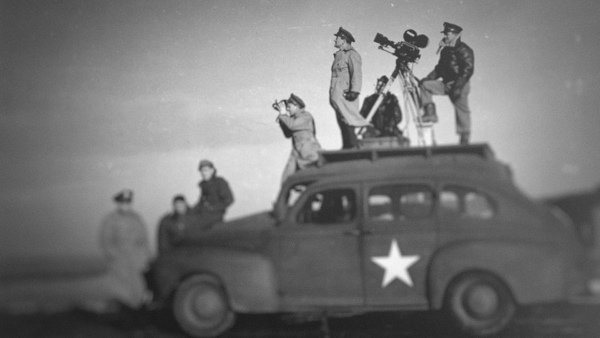Movie review by Greg Carlson
Veteran “making of” producer/director Laurent Bouzereau adds another Hollywood-centric chronicle to his filmography with the three-episode series “Five Came Back.” Adapted for the screen by author Mark Harris from his book of the same title, the story of the motion picture industry’s curious relationship with the United States government during World War II makes for a riveting history lesson. The incorporation of extensive clips from movies directed by the title quintet is the film’s principal advantage over the original text, but Bouzereau and Harris omit much of the subtlety, nuance, and depth that informed the reader about the egos, personalities, and priorities of Frank Capra, John Ford, John Huston, George Stevens, and William Wyler.
Each of the classic directors is paired with a current moviemaker, and the tactic provides a keen sense of symmetry. Guillermo del Toro speaks about Capra. Paul Greengrass tackles Ford. Francis Ford Coppola examines Huston. Lawrence Kasdan explains Stevens. Steven Spielberg, also serving as an executive producer on the project, covers Wyler. Additionally, Meryl Streep narrates. Cinephiles will visit “Five Came Back” with favorites from that wartime group already in place, but Bouzereau labors to balance the set. Not everyone ends up with equal time, but the director carves out at least one shining moment per creator.
Some of those moments reside within the cohort’s fiction features completed prior to entering military service, but Bouzereau really capitalizes on how their postwar output was so powerfully informed by what each of the filmmakers personally experienced when serving. The somber introspection of sacrifice in “They Were Expendable” (Ford, 1945), the monumental humanity of “The Best Years of Our Lives” (Wyler, 1946), and the startling use of shadow and light in “The Diary of Anne Frank” (Stevens, 1959) are just a handful of examples.
In all three installments, “Five Came Back” highlights key productions crafted by the Hollywood storytellers. The coverage of the notable works is intriguing enough to whet the appetite of viewers who may not have seen them, and a select few of the films could certainly sustain entire episodes. Among the most tantalizing are Huston’s “The Battle of San Pietro,” which combined a display of previously unimagined realism with staged reenactments of combat, and Wyler’s “The Memphis Belle: A Story of a Flying Fortress,” one of the war effort’s finest mergers of documentary artistry and “embedded” reporting (long before the term was popularized).
In the final chapter, the carnage witnessed during the June 6, 1944 D-Day landing of Allied forces on the Normandy coast — chronicled by both Ford and Stevens — led the former to a blinding alcoholic binge and the latter to a determined march forward into Europe. Stevens, of course, would in essence stumble into Dachau. His commitment to capturing the unimaginable horrors marks some of the most memorable content of both the book and the documentary. As Harris wrote, “Stevens kept filming, his camera pushing into corners and shadows, his movements steady as he recorded the carnage that surrounded him. His eye was unwavering and unsentimental.”
One wishes there was more room to unpack the complexities of films like “The Negro Soldier” (Stuart Heisler, 1944) and the long suppressed “Let There Be Light” (Huston, 1946; not widely seen until the early 1980s). Not surprisingly, Bouzereau, Spielberg, and the others maintain a reverential tone of deep respect for the Greatest Generation that undercuts opportunities to critique the limitations of propaganda in the broadest sense of the concept. The time crunch of the series accounts for some of that superficiality, and to Bouzereau’s credit, “Five Came Back” acknowledges the grim racism that reductively dehumanized certain enemies more than others, contributing to a xenophobic climate that shamefully facilitated the mass incarceration of Japanese Americans.
